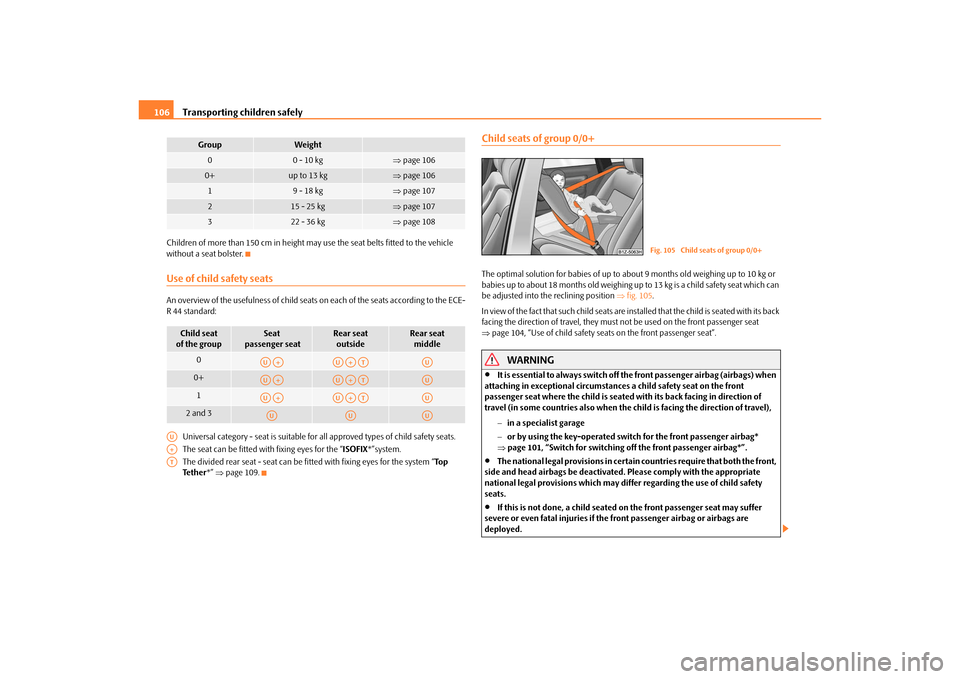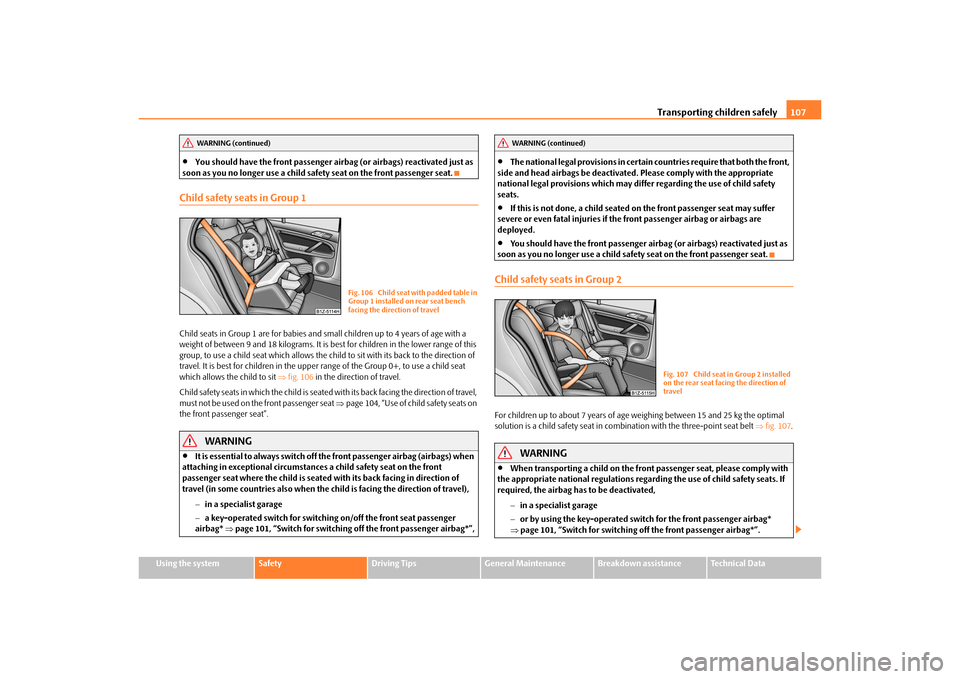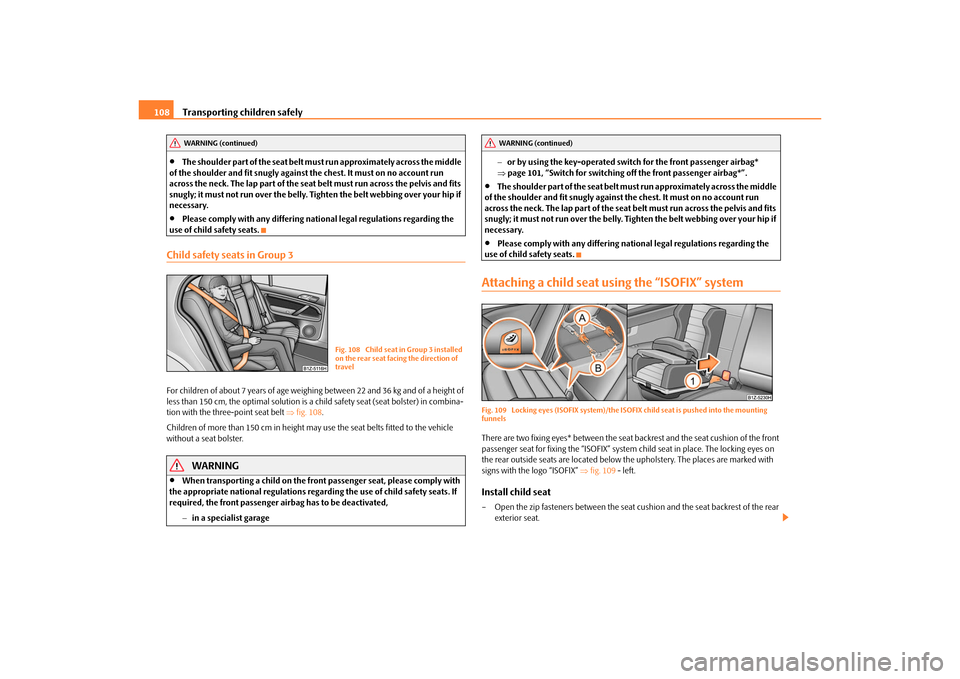Page 107 of 199

Transporting children safely
106
Children of more than 150 cm in height may use the seat belts fitted to the vehicle
without a seat bolster.Use of child safety seatsAn overview of the usefulness of child seats on each of the seats according to the ECE-
R44 standard:
Universal category - seat is suitable for all approved types of child safety seats.
The seat can be fitted with fixing eyes for the “ ISOFIX*”system.
The divided rear seat - seat can be fitt ed with fixing eyes for the system “To p
Te t h e r *” page 109.
Child seats of group 0/0+The optimal solution for babies of up to about 9 months old weighing up to 10 kg or
babies up to about 18 months old weighing up to 13 kg is a child safety seat which can
be adjusted into the reclining position fig. 105 .
In view of the fact that such child seats are installed that the child is seated with its back
facing the direction of travel, they must not be used on the front passenger seat
page 104, “Use of child safety seats on the front passenger seat”.
WARNING
It is essential to always switch off th e front passenger airbag (airbags) when
attaching in exceptional circumstances a child safety seat on the front
passenger seat where the child is seated with its back facing in direction of
travel (in some countries also when the child is facing the direction of travel),
in a specialist garage
or by using the key-operated swit ch for the front passenger airbag*
page 101, “Switch for switching off the front passenger airbag*”.
The national legal provisions in certain countries require that both the front,
side and head airbags be deactivated. Please comply with the appropriate
national legal provisions which may diff er regarding the use of child safety
seats.
If this is not done, a child seated on the front passenger seat may suffer
severe or even fatal injuries if the front passenger airbag or airbags are
deployed.
Group
Weight
0
0 - 10 kg
page 106
0+
up to 13 kg
page 106
1
9 - 18 kg
page 107
2
15 - 25 kg
page 107
3
22 - 36 kg
page 108
Child seat
of the group
Seat
passenger seat
Rear seat outside
Rear seat middle
0
0+
1
2 and 3
AUA+
AUA+AT
AU
AUA+
AUA+AT
AU
AUA+
AUA+AT
AU
AU
AU
AU
AUA+AT
Fig. 105 Child seats of group 0/0+
s2bs.2.book Page 106 Monday, September 27, 2010 9:53 AM
Page 108 of 199

Transporting children safely107
Using the system
Safety
Driving Tips
General Maintenance
Breakdown assistance
Technical Data
You should have the front passenger airbag (or airbags) reactivated just as
soon as you no longer use a child safe ty seat on the front passenger seat.
Child safety seats in Group 1Child seats in Group 1 are for babies and small children up to 4 years of age with a
weight of between 9 and 18 kilograms. It is best for children in the lower range of this
group, to use a child seat which allows the ch ild to sit with its back to the direction of
travel. It is best for children in the uppe r range of the Group 0+, to use a child seat
which allows the child to sit fig. 106 in the direction of travel.
Child safety seats in which the child is seated with its back facing the direction of travel,
must not be used on the front passenger seat page 104, “Use of child safety seats on
the front passenger seat”.
WARNING
It is essential to always switch off th e front passenger airbag (airbags) when
attaching in exceptional circumstances a child safety seat on the front
passenger seat where the child is seated with its back facing in direction of
travel (in some countries also when the child is facing the direction of travel),
in a specialist garage
a key-operated switch for switching on/off the front seat passenger
airbag* page 101, “Switch for switching of f the front passenger airbag*”,
The national legal provisions in certain countries require that both the front,
side and head airbags be deactivated. Please comply with the appropriate
national legal provisions which may diff er regarding the use of child safety
seats.
If this is not done, a child seated on the front passenger seat may suffer
severe or even fatal injuries if the front passenger airbag or airbags are
deployed.
You should have the front passenger airbag (or airbags) reactivated just as
soon as you no longer use a child safe ty seat on the front passenger seat.
Child safety seats in Group 2For children up to about 7 years of age weighing between 15 and 25 kg the optimal
solution is a child safety seat in combination with the three-point seat belt fig. 107 .
WARNING
When transporting a child on the front passenger seat, please comply with
the appropriate national regulations regard ing the use of child safety seats. If
required, the airbag has to be deactivated,
in a specialist garage
or by using the key-operated swit ch for the front passenger airbag*
page 101, “Switch for switching off the front passenger airbag*”.
WARNING (continued)
Fig. 106 Child seat with padded table in
Group 1 installed on rear seat bench
facing the direction of travel
WARNING (continued)
Fig. 107 Child seat in Group 2 installed
on the rear seat facing the direction of
travel
s2bs.2.book Page 107 Monday, September 27, 2010 9:53 AM
Page 109 of 199

Transporting children safely
108
The shoulder part of the seat belt mu st run approximately across the middle
of the shoulder and fit snugly against the chest. It must on no account run
across the neck. The lap part of the seat belt must run across the pelvis and fits
snugly; it must not run over the belly. Tighten the belt webbing over your hip if
necessary.
Please comply with any differing nati onal legal regulations regarding the
use of child safety seats.
Child safety seats in Group 3For children of about 7 years of age weighing between 22 and 36 kg and of a height of
less than 150 cm, the optimal solution is a ch ild safety seat (seat bolster) in combina-
tion with the three-point seat belt fig. 108 .
Children of more than 150 cm in height may use the seat belts fitted to the vehicle
without a seat bolster.
WARNING
When transporting a child on the front passenger seat, please comply with
the appropriate national regu lations regarding the use of child safety seats. If
required, the front passenger ai rbag has to be deactivated,
in a specialist garage
or by using the key-operated swit ch for the front passenger airbag*
page 101, “Switch for switching off the front passenger airbag*”.
The shoulder part of the seat belt mu st run approximately across the middle
of the shoulder and fit snugly against the chest. It must on no account run
across the neck. The lap part of the seat belt must run across the pelvis and fits
snugly; it must not run over the belly. Tighten the belt webbing over your hip if
necessary.
Please comply with any differing nati onal legal regulations regarding the
use of child safety seats.
Attaching a child seat using the “ISOFIX” systemFig. 109 Locking eyes (ISOFIX system)/the ISOF IX child seat is pushed into the mounting
funnelsThere are two fixing eyes* between the seat backrest and the seat cushion of the front
passenger seat for fixing the “ISOFIX” system child seat in place. The locking eyes on
the rear outside seats are located below th e upholstery. The places are marked with
signs with the logo “ISOFIX” fig. 109 - left.Install child seat– Open the zip fasteners between the seat cushion and the seat backrest of the rear
exterior seat.
WARNING (continued)
Fig. 108 Child seat in Group 3 installed
on the rear seat facing the direction of
travel
WARNING (continued)
s2bs.2.book Page 108 Monday, September 27, 2010 9:53 AM